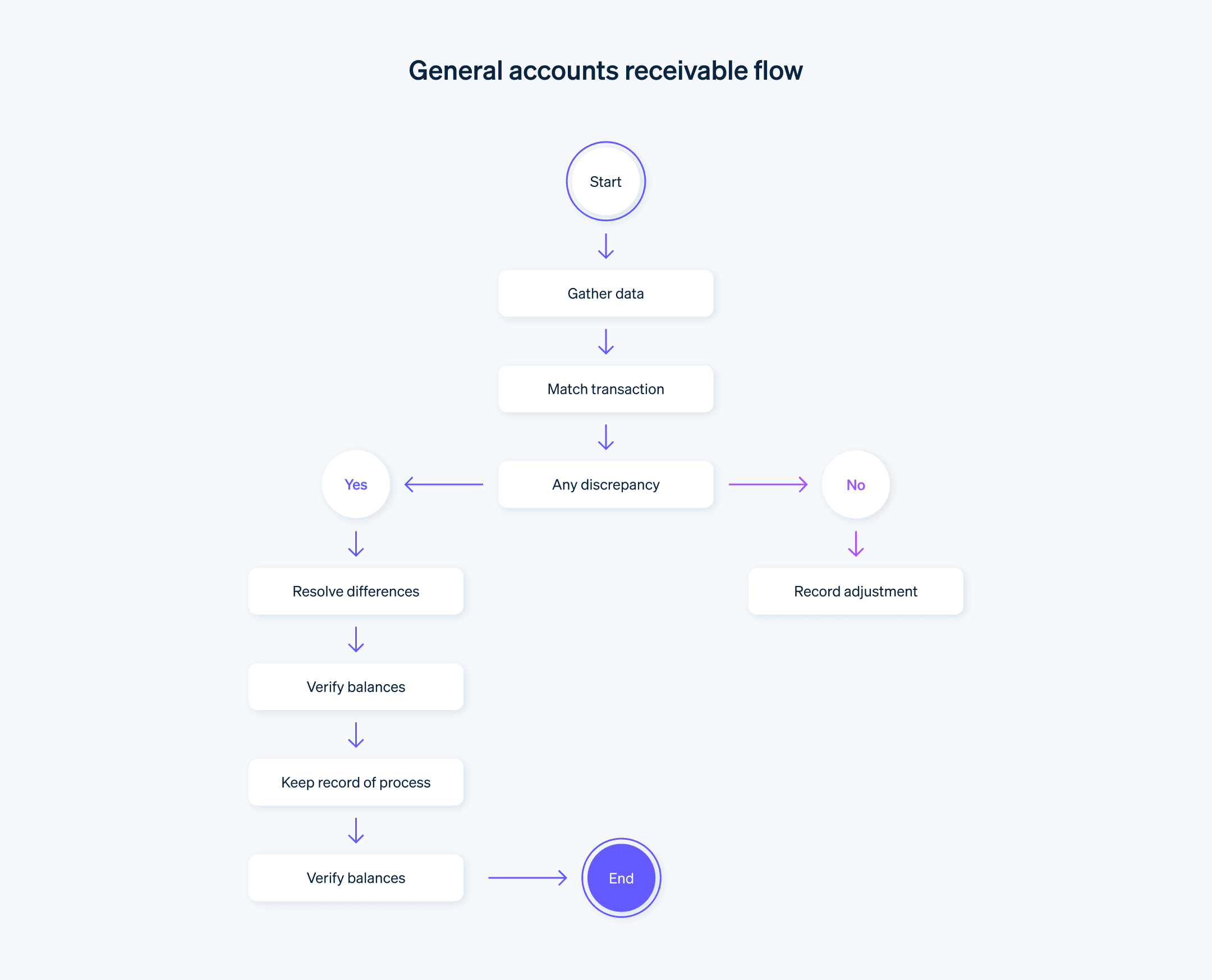การกระทบยอดบัญชีมีบทบาทพื้นฐานในการตรวจสอบให้มั่นใจว่างบการเงินมีความน่าเชื่อถือ ตรวจจับข้อผิดพลาด การป้องกันการฉ้อโกง และการปฏิบัติตามข้อกําหนดทางกฎหมาย ธุรกิจที่ให้ความสำคัญกับแนวทางการกระทบยอดที่มีประสิทธิผลจะสามารถทำการตัดสินใจอย่างมีข้อมูล บรรเทาความเสี่ยง และรักษาสุขภาพทางการเงินที่จำเป็นต่อความสำเร็จในระยะยาวได้อย่างดีเยี่ยม
จากแบบสํารวจที่ดําเนินการโดยสมาคมผู้ตรวจสอบการฉ้อโกงที่ผ่านการรับรอง (ACFE)ระบุว่า การฉ้อโกงในงบการเงินมีคิดเป็น 9% ของกรณีการฉ้อโกงที่รายงานในปี 2022 ประเด็นนี้เน้นให้เห็นถึงความสําคัญที่การกระทบยอดการทำบัญชีที่ถูกต้องมีต่อการตรวจจับและป้องกันกิจกรรมการฉ้อโกงภายในองค์กร การกระทบยอดบันทึกทางการเงิน เช่น ใบแจ้งยอดธนาคาร ใบแจ้งหนี้ และใบเสร็จรับเงิน ช่วยให้ธุรกิจระบุความคลาดเคลื่อนและความผิดปกติ และป้องกันตนเองจากการฉ้อโกงที่อาจเกิดขึ้นได้
เราจะอธิบายแนวทางปฏิบัติและกลยุทธ์ที่ดีที่สุดที่องค์กรต่างๆ สามารถใช้เพื่อปรับกระบวนการกระทบยอดให้มีประสิทธิภาพ ลดข้อผิดพลาด และสร้างรากฐานที่มั่นคงสำหรับการจัดการทางการเงินได้
บทความนี้ให้ข้อมูลอะไรบ้าง
- การกระทบยอดการทําบัญชีคืออะไร
- ประเภทของการกระทบยอดการทําบัญชี
- ทําไมการกระทบยอดการทําบัญชีจึงสําคัญต่อธุรกิจ
- แนวทางปฏิบัติที่ดีที่สุดในการกระทบยอดการทำบัญชี
- การกระทบยอดการทําบัญชีกับ Stripe
การกระทบยอดการทําบัญชีคืออะไร
ในการทำบัญชี การกระทบยอดหมายถึงกระบวนการเปรียบเทียบชุดบันทึกหรือข้อมูลทางการเงินสองชุด เช่น ใบแจ้งยอดธนาคาร บัญชีแยกประเภททั่วไป หรือบันทึกอื่นๆ ที่เกี่ยวข้อง เพื่อให้แน่ใจว่ามีความถูกต้องและสอดคล้องกัน
วัตถุประสงค์หลักในการกระทบยอดคือเพื่อระบุและแก้ไขข้อมูลที่ไม่ตรงกันระหว่างบันทึกทั้งสองชุด การทำเช่นนี้ช่วยรักษาความสมบูรณ์ของงบการเงินและตรวจจับข้อผิดพลาดหรือกิจกรรมการฉ้อโกง

ประเภทของการกระทบยอดการทําบัญชี
การกระทบยอดการทําบัญชีเกี่ยวข้องกับการเปรียบเทียบและยืนยันธุรกรรมทางการเงินและยอดคงเหลือเพื่อระบุและแก้ไขความคลาดเคลื่อน การกระทบยอดการทำบัญชีแบ่งออกเป็นประเภทต่างๆ ดังนี้
การกระทบยอดธนาคาร
การเปรียบเทียบธุรกรรมและยอดคงเหลือในใบแจ้งยอดธนาคารของธุรกิจกับรายการในสมุดเงินสดหรือบัญชีแยกประเภททั่วไปการกระทบยอดลูกหนี้การค้า
การตรวจสอบความถูกต้องและความสมบูรณ์ของยอดคงเหลือในลูกหนี้การค้าโดยเปรียบเทียบกับเอกสารประกอบ เช่น ใบแจ้งหนี้ลูกค้าและใบเสร็จรับเงินการกระทบยอดเจ้าหนี้การค้า
การตรวจสอบความถูกต้องและความสมบูรณ์ของยอดคงเหลือในเจ้าหนี้การค้าโดยเปรียบเทียบกับใบแจ้งหนี้ของซัพพลายเออร์และบันทึกการชำระเงินการกระทบยอดระหว่างบริษัท
การกระทบยอดธุรกรรมระหว่างบริษัทและยอดคงเหลือระหว่างบริษัทย่อยหรือหน่วยงานเพื่อความถูกต้องแม่นยําและขจัดข้อผิดพลาดการกระทบยอดสินค้าคงคลัง
การเปรียบเทียบจํานวนสินค้าคงคลังที่มีอยู่จริงกับยอดคงเหลือสินค้าคงคลังที่บันทึกไว้เพื่อระบุข้อมูลที่คลาดเคลื่อนและแก้ไขปัญหา เช่น การโจรกรรมหรือการบันทึกข้อมูลผิดพลาดการกระทบยอดบัญชีแยกประเภททั่วไป
การกระทบยอดบัญชีแยกประเภททั่วไปต่างๆ เพื่อให้แน่ใจว่าธุรกรรมและยอดคงเหลือที่บันทึกไว้สมบูรณ์และถูกต้องการกระทบยอดสินทรัพย์ถาวร
การตรวจสอบบันทึกสินทรัพย์ถาวรโดยเปรียบเทียบกับใบแจ้งหนี้ซื้อ ตารางค่าเสื่อมราคา และบันทึกการกำจัดการกระทบยอดภาษี
เปรียบเทียบบันทึกภาษี เช่น ภาษีขายหรือภาษีเงินได้ กับบันทึกทางการเงินที่เกี่ยวข้อง เพื่อให้แน่ใจว่าการรายงานหนี้ภาษีมีความถูกต้องการกระทบยอดบัตรเครดิตและบัตรเดบิต
การจับคู่ธุรกรรมที่บันทึกไว้ในใบแจ้งยอดบัตรเครดิตหรือบัตรเดบิตกับบันทึกทางการเงินเพื่อให้แน่ใจถึงความถูกต้องและครบถ้วนการกระทบยอดกระเป๋าเงินดิจิทัล
การยืนยันธุรกรรมกระเป๋าเงินดิจิทัลโดยเทียบกับบันทึกทางการเงินของธุรกิจการกระทบยอดสกุลเงินทั่วโลก
การตรวจสอบความถูกต้องของธุรกรรมในสกุลเงินต่างประเทศ โดยการเปรียบเทียบกับอัตราแลกเปลี่ยนและบันทึกทางการเงินการกระทบยอดการชําระเงินอัตโนมัติแบบเรียลไทม์
การทำให้กระบวนการกระทบยอดการชำระเงินเกิดขึ้นอัตโนมัติแบบเรียลไทม์ เพื่อจับคู่และกระทบยอดการชำระเงินอย่างถูกต้องและมีประสิทธิภาพ
การกระทบยอดประเภทต่างๆ เหล่านี้มีความสำคัญต่อการรักษาบันทึกทางการเงินที่ถูกต้อง การตรวจจับข้อผิดพลาดและการฉ้อโกง และการรับรองความน่าเชื่อถือของระบบบัญชี โดยจะมอบภาพที่ชัดเจนและถูกต้องเกี่ยวกับสถานะทางการเงินให้กับองค์กร ซึ่งทำให้พวกเขาสามารถทำการตัดสินใจทางธุรกิจอย่างรอบรู้ได้
ทําไมการกระทบยอดการทําบัญชีจึงสําคัญต่อธุรกิจ
การกระทบยอดการทําบัญชีเป็นสิ่งที่สําคัญสําหรับธุรกิจ เหตุผลมีดังนี้
ข้อมูลทางการเงินที่ถูกต้อง
เมื่อทำการเปรียบเทียบชุดข้อมูลที่แตกต่างกัน การกระทบยอดจะช่วยให้แน่ใจได้ว่าบันทึกทางการเงินมีความถูกต้องและเชื่อถือได้ เมื่อธุรกิจดำเนินการหรือบันทึกธุรกรรมทางการเงิน ความคลาดเคลื่อน ข้อผิดพลาด และการละเว้นอาจเกิดขึ้นได้ และการตรวจสอบความถูกต้องจะช่วยระบุความคลาดเคลื่อนเหล่านี้และช่วยทำการแก้ไข ซึ่งจะทำให้มั่นใจได้ว่างบการเงินและรายงานต่างๆ จะแสดงมุมมองที่ถูกต้องและเป็นธรรมเกี่ยวกับสถานะทางการเงินของธุรกิจระบบตรวจจับการฉ้อโกง
การกระทบยอดเป็นกลไกการควบคุมภายในที่สําคัญในการตรวจจับกิจกรรมที่เป็นการฉ้อโกง ด้วยการเปรียบเทียบบันทึกต่างๆ เช่น ใบแจ้งยอดธนาคาร ใบแจ้งหนี้ และใบเสร็จรับเงิน ธุรกิจสามารถระบุความคลาดเคลื่อนหรือความผิดปกติที่อาจบ่งชี้ถึงธุรกรรมฉ้อโกงได้ จึงสามารถปกป้องทรัพย์สินและผลประโยชน์ทางการเงินของธุรกิจการตัดสินใจ
การกระทบยอดจะช่วยให้มั่นใจได้ว่าข้อมูลที่ใช้สําหรับการตัดสินใจนั้นน่าเชื่อถือและสมบูรณ์ การกระทบยอดการทำบัญชีและบันทึกทางการเงินที่แตกต่างกันจะทำให้ธุรกิจมีความมั่นใจในความแม่นยำของข้อมูล และสามารถทำการตัดสินใจเชิงกลยุทธ์โดยอาศัยข้อมูลเชิงลึกทางการเงินที่เชื่อถือได้การปฏิบัติตามกฎและข้อกําหนดทางกฎหมาย
การกระทบยอดช่วยให้ธุรกิจปฏิบัติตามข้อกําหนดและหน้าที่ด้านการกํากับดูแล ตัวอย่างเช่น เมื่อทำการกระทบยอดบัญชีธนาคารที่ถูกต้อง ธุรกิจจะสามารถมั่นใจได้ว่าตนเองปฏิบัติตามมาตรฐานการตรวจสอบ และจัดทำงบการเงินที่ปฏิบัติตามแนวทางการกำกับดูแล การไม่สามารถกระทบยอดการทำบัญชีอย่างถูกต้องอาจก่อให้เกิดความไม่สอดคล้อง บทลงโทษ หรือผลกระทบทางกฎหมายได้การจัดการความเสี่ยง
การกระทบยอดบัญชีช่วยจัดการความเสี่ยงทางการเงินด้วยการระบุข้อผิดพลาด ความไม่ตรงกัน หรือความผิดปกติได้อย่างทันท่วงที การกระทบยอดการทำบัญชีช่วยให้ธุรกิจสามารถตรวจจับความเสี่ยงที่อาจเกิดขึ้น เช่น ปัญหาการหมุนเวียนของเงินสด ความไม่ตรงกันของสินค้าคงคลัง และการคำนวณภาษีที่ไม่ถูกต้อง การระบุความเสี่ยงตั้งแต่เนิ่นๆ จะช่วยให้ธุรกิจดําเนินการตามความเหมาะสมและรักษาความมั่นคงทางการเงินของตัวเองได้สร้างความไว้วางใจให้ผู้มีส่วนเกี่ยวข้อง
การกระทบยอดหมายถึงการที่งบการเงินได้รับการจัดทำด้วยความซื่อสัตย์และโปร่งใส ซึ่งสร้างความไว้วางใจและความน่าเชื่อถือต่อผู้มีส่วนเกี่ยวข้อง เช่น นักลงทุน ผู้ให้กู้ และผู้ถือหุ้น ความเชื่อมั่นนี้จะเสริมสร้างชื่อเสียงของธุรกิจและเพิ่มความมั่นใจในสถานะทางการเงิน
แนวทางปฏิบัติที่ดีที่สุดในการกระทบยอดการทำบัญชี
ธุรกิจสามารถยกระดับความถูกต้องของบันทึกทางการเงิน เสริมความแข็งแกร่งให้กับการควบคุมภายใน ตรวจจับและป้องกันการฉ้อโกง และปฏิบัติตามข้อกําหนดทางกฎหมายได้โดยการทําตามแนวทางปฏิบัติที่ดีที่สุดในการกระทบยอดการทำบัญชีเหล่านี้ แนวทางปฏิบัติเหล่านี้มีส่วนทำให้เกิดการรายงานทางการเงินที่เชื่อถือได้ ซึ่งเป็นสิ่งสําคัญในการดําเนินงานและขยายธุรกิจเกือบทุกด้าน
แนวทางปฏิบัติที่ดีที่สุดในการกระทบยอดการทําบัญชีสําหรับธุรกิจมีดังนี้
การกระทบยอดเป็นประจํา
กระทบยอดเป็นประจําทุกเดือน หรือบ่อยครั้งตามความจําเป็น โดยอิงตามปริมาณธุรกรรม การกระทบยอดที่รวดเร็วและสม่ำเสมอหมายความว่าธุรกิจจะสามารถระบุและแก้ไขความคลาดเคลื่อนได้อย่างรวดเร็ว ก่อนที่จะทำให้เกิดปัญหาในภายหลังเอกสารประกอบและการเก็บบันทึก
รักษาเอกสารรายละเอียดของกระบวนการกระทบยอด เช่น ใบแจ้งยอดธนาคาร ใบแจ้งหนี้ ใบเสร็จ และบันทึกอื่นๆ ที่เกี่ยวข้อง การจัดทำเอกสารสำหรับกระบวนการกระทบยอดอย่างเหมาะสมจะช่วยให้การตรวจสอบหรือการทบทวนในอนาคตง่ายขึ้น และช่วยระบุและแก้ไขข้อขัดแย้งได้การแบ่งแยกหน้าที่
ใช้การแบ่งแยกหน้าที่เพื่อให้แน่ใจว่าบุคคลแต่ละคนจะรับผิดชอบด้านต่างๆ ของกระบวนการ เช่น การบันทึก การกระทบยอด และการอนุมัติธุรกรรมทางการเงิน การแยกหน้าที่นี้รับประกันว่าจะมีสายตาหลายๆ คู่คอยตรวจสอบข้อมูลทางการเงินในจุดต่างๆ ในกระบวนการกระทบยอด ซึ่งช่วยป้องกันข้อผิดพลาดและการฉ้อโกงได้ขั้นตอนการกระทบยอดที่ชัดเจน
กำหนดกระบวนการกระทบยอดที่ได้มาตรฐาน โดยกำหนดขั้นตอนที่เหมาะสม บทบาทและความรับผิดชอบของแต่ละบุคคล และกำหนดเวลาที่ชัดเจน ขั้นตอนที่ชัดเจนจะส่งเสริมความสอดคล้อง ลดข้อผิดพลาด และทำให้แน่ใจว่ากระบวนการกระทบยอดดำเนินไปอย่างเป็นระเบียบการกระทบยอดอัตโนมัติ
หากเป็นไปได้ ให้ใช้ซอฟต์แวร์การทําบัญชีหรือเครื่องมือการกระทบยอดเพื่อดำเนินการตามขั้นตอนการกระทบยอดโดยอัตโนมัติ ระบบอัตโนมัติจะลดข้อผิดพลาดจากการดําเนินการโดยเจ้าหน้าที่ ปรับปรุงประสิทธิผล และมอบกรอบการทำงานแบบเป็นระบบสําหรับการกระทบยอดบัญชีและบันทึกการเปรียบเทียบและการสอบสวน
เปรียบเทียบบันทึกทางการเงินอย่างถี่ถ้วนเพื่อระบุข้อมูลที่คลาดเคลื่อน ตรวจสอบและแก้ไขข้อมูลที่ไม่ตรงกันเหล่านี้ทันทีโดยการติดตามต้นตอของปัญหา การแก้ไขข้อผิดพลาด และการปรับบันทึกทางการเงินให้สอดคล้องกัน การตรวจสอบที่เหมาะสมจะช่วยป้องกันข้อผิดพลาดที่เกิดขึ้นซ้ําๆ และตรวจสอบให้มั่นใจว่าข้อมูลทางการเงินมีความถูกต้องการสื่อสารอย่างต่อเนื่อง
ส่งเสริมการสื่อสารแบบเปิดระหว่างแผนกและบุคคลที่เกี่ยวข้องในกระบวนการกระทบยอด การสื่อสารเป็นประจําช่วยแก้ไขปัญหา อธิบายข้อสงสัย และแชร์ข้อมูลได้อย่างมีประสิทธิภาพ ขั้นตอนการกระทบยอดที่ครอบคลุมและถูกต้องนั้นขึ้นอยู่กับการทํางานร่วมกันและการประสานงานของผู้มีส่วนเกี่ยวข้องแต่ละรายการตรวจสอบและการอนุมัติการกระทบยอด
ดำเนินการตามกระบวนการตรวจสอบและอนุมัติเพื่อให้แน่ใจว่ามีการตรวจสอบบันทึกที่ได้รับการกระทบยอดอย่างเป็นอิสระ กระบวนการนี้ควรประกอบด้วยการตรวจสอบความถูกต้องและความเหมาะสมของยอดคงเหลือที่กระทบยอดแล้ว และการตรวจสอบความคลาดเคลื่อนที่สำคัญใดๆ นอกจากนี้ การอนุมัติโดยหน่วยงานที่กําหนดจะเพิ่มการรับประกันอีกชั้นหนึ่งให้กับกระบวนการกระทบยอดปรับปรุงอย่างต่อเนื่อง
ประเมินและปรับปรุงกระบวนการกระทบยอดเป็นประจําด้วยการระบุส่วนที่ควรปรับปรุง วิเคราะห์รูปแบบของข้อมูลที่คลาดเคลื่อน ระบุจุดอ่อนที่อาจเกิดขึ้น และใช้มาตรการที่เหมาะสมเพื่อป้องกันข้อผิดพลาดในอนาคต การปรับปรุงขั้นตอนการกระทบยอดอย่างต่อเนื่องจะช่วยให้ธุรกิจสามารถเพิ่มความแม่นยำ ประสิทธิภาพ และการควบคุมทางการเงินโดยรวมได้สูงสุด
การกระทบยอดการทําบัญชีกับ Stripe
Stripe มอบโซลูชันการกระทบยอดที่มีประสิทธิภาพซึ่งจะยกระดับกระบวนการสําหรับธุรกิจ โซลูชันการกระทบยอดของ Stripe จะดำเนินการขั้นตอนการกระทบยอดกับธุรกิจได้โดยอัตโนมัติ และนําเสนอภาพรวมที่ครอบคลุมของการรับส่งเงิน
ขั้นตอนการกระทบยอดของ Stripe นั้นประกอบด้วยการเปรียบเทียบบันทึกภายในของธุรกิจ คุณ เช่น ใบแจ้งหนี้ กับบันทึกภายนอก เช่น ไฟล์การชําระเงิน ไฟล์เบิกจ่าย และใบแจ้งยอดธนาคาร ระบบอัตโนมัติของ Stripe จัดการการเปรียบเทียบนี้ ทำให้คุณสามารถบันทึกรายรับได้อย่างถูกต้อง และปรับปรุงระบบการบัญชีภายในของคุณให้สอดคล้องกับค่าธรรมเนียมและการคืนเงินที่ Stripe ดำเนินการในระดับธุรกรรม
โซลูชันการกระทบยอด Stripe มีประโยชน์ต่อธุรกิจหลายประการ ดังนี้
ช่วยให้คุณติดตามเงินสดในแต่ละวัน เพื่อให้บันทึกทางการเงินของคุณสอดคล้องกับเงินที่ได้รับ การระบุช่องว่างในกระแสเงินหรือความคลาดเคลื่อนของข้อมูล จะทำให้คุณสามารถแก้ไขการรั่วไหลได้อย่างรวดเร็วและลดการสูญเสียทางการเงินให้น้อยที่สุด
การกระทบยอดของ Stripe ช่วยให้ทราบวงจรของธุรกรรมแต่ละรายการอย่างสมบูรณ์ คุณสามารถติดตามและตรวจสอบกระแสเงินทุนได้อย่างง่ายดาย เพื่อให้แน่ใจว่าธุรกรรมทุกรายการจะได้รับการบันทึกและลงบัญชีอย่างถูกต้อง ความโปร่งใสในระดับนี้จะช่วยปกป้องธุรกิจของคุณด้วยการระบุข้อผิดพลาดหรือสิ่งผิดปกติที่อาจเกิดขึ้น
การกระทบยอดของ Stripe มีประโยชน์เป็นพิเศษสําหรับธุรกิจที่มีปริมาณธุรกรรมสูง หากธุรกิจของคุณประมวลผลธุรกรรมหลายพันรายการในแต่ละเดือน ระบบอัตโนมัติและความสามารถในการขยายขอบเขตโซลูชันการกระทบยอดของ Stripe จะช่วยเพิ่มประสิทธิภาพให้กับการปฏิบัติงานทางการเงินของคุณ
หากธุรกิจของคุณจัดการกับสถานการณ์ธุรกรรมที่ซับซ้อน เช่น วงจรการทําธุรกรรมที่ยาวนานซึ่งแบ่งเป็นหลายรอบการชำระเงิน หรือลูกค้าที่ใช้วิธีการชําระเงินหลายวิธีในการทําธุรกรรมรายการเดียว โซลูชันการกระทบยอดของ Stripe จะจัดการกับความซับซ้อนเหล่านี้ได้อย่างมีประสิทธิภาพ มอบความยืดหยุ่นและความถูกต้องที่จําเป็นเพื่อกระทบยอดประเภทธุรกรรมที่หลากหลายและช่วยให้มั่นใจว่าการรายงานทางการเงินมีความถูกต้อง
โซลูชันการกระทบยอดของ Stripe จะดําเนินการโดยอัตโนมัติและทําให้กระบวนการเปรียบเทียบบันทึกภายในกับบันทึกภายนอกเป็นเรื่องง่าย ช่วยให้ธุรกิจข้อมูลรายรับได้อย่างแม่นยํา ติดตามกระแสเงินสด ระบุข้อมูลที่ไม่ตรงกัน และใช้มาตรการควบคุมทางการเงินที่มีประสิทธิภาพ ไม่ว่าคุณจะมีปริมาณธุรกรรมสูงหรือมีสถานการณ์ธุรกรรมที่ซับซ้อน โซลูชันการกระทบยอดของ Stripe จะให้การสนับสนุนที่ปรับขนาดได้และน่าเชื่อถือสําหรับการปฏิบัติงานทางการเงินของคุณ หากต้องการข้อมูลเพิ่มเติมหรือเริ่มใช้งาน โปรดไปที่นี่
เนื้อหาในบทความนี้มีไว้เพื่อให้ข้อมูลทั่วไปและมีจุดประสงค์เพื่อการศึกษาเท่านั้น ไม่ควรใช้เป็นคําแนะนําทางกฎหมายหรือภาษี Stripe ไม่รับประกันหรือรับประกันความถูกต้อง ความสมบูรณ์ ความไม่เพียงพอ หรือความเป็นปัจจุบันของข้อมูลในบทความ คุณควรขอคําแนะนําจากทนายความที่มีอํานาจหรือนักบัญชีที่ได้รับใบอนุญาตให้ประกอบกิจการในเขตอํานาจศาลเพื่อรับคําแนะนําที่ตรงกับสถานการณ์ของคุณ